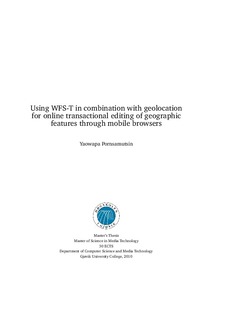| dc.description.abstract | While online maps have been widely used in the society, the number of providers who develop applications to serve those users needs have also been increasing. To make use of data or exchange data from each provider, some standards are involved. The OpenGIS Consortium (OGC) is an association offering certain standards for geoprocessing which can be helped in developing and implementing software. The purpose of this project is to use WFS-T in combination with geolocation for online transactional editing of geographic features through mobile browsers on mobile phones based on one of OGC standards called WFS (Web Feature Service), which WFS-T (Transactional Web Feature Service) is a part of WFS. With WFS-T, users can perform transactional operations such as create, update and delete geographic features. Geographic features can be described as a set of properties which may include a name, type and value. For example, one country can be defined as a geographic feature containing the following properties: {country name, country capital, country lonlat, country population}; each property can have different type and value such as country name has a type as string and has a value as Norway while country population has a type as number and has a value as 4882600. In this implementation, GeoServer is selected to be used as GIS server software, PostgreSQL with PostGIS is used as datastore and OpenLayers is used in creating web-based geographic application. Additionally, W3C Geolocation API is used to detect users’ locations from using their devices, in this case, an Android phone is used as a test device during the implementation. Once users launch their mobile browsers to connect to the Internet. The application will figure the users’ locations and show the position as a point on a map through their mobile browsers. Moreover, the amenity places around their area will be displayed. The prototype allows users to make online transactions such as insert a new point as a new place. When users finish and save their work, all data will be recorded in the database via WFS-T operations. The project report will give readers some background information about geolocation, the OpenGIS Standards including concepts and technologies of GIS and mobile browsers, how the prototype is created, and also the results of the implementation to provide information for those who are interested in using WFS-T to edit geographic features through web browsers on mobile phones. | en_US |
